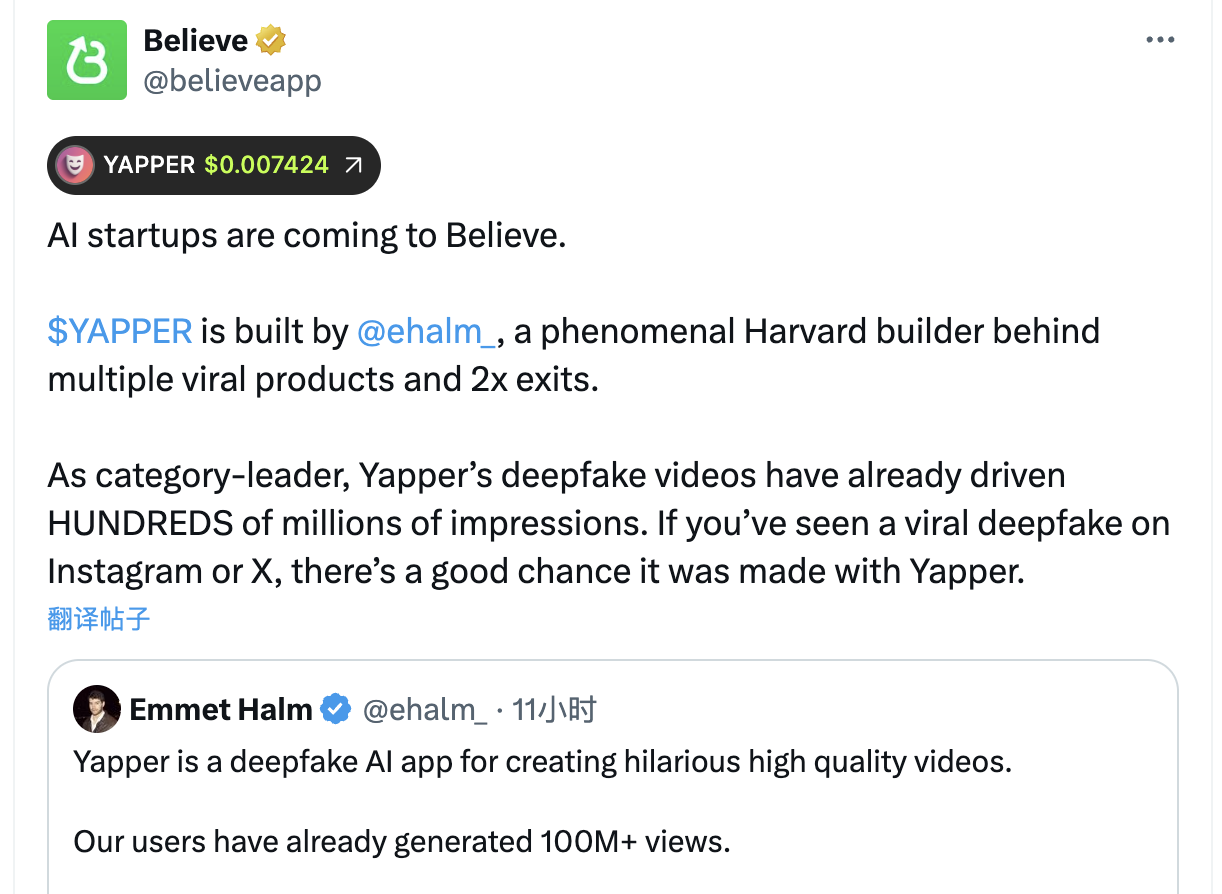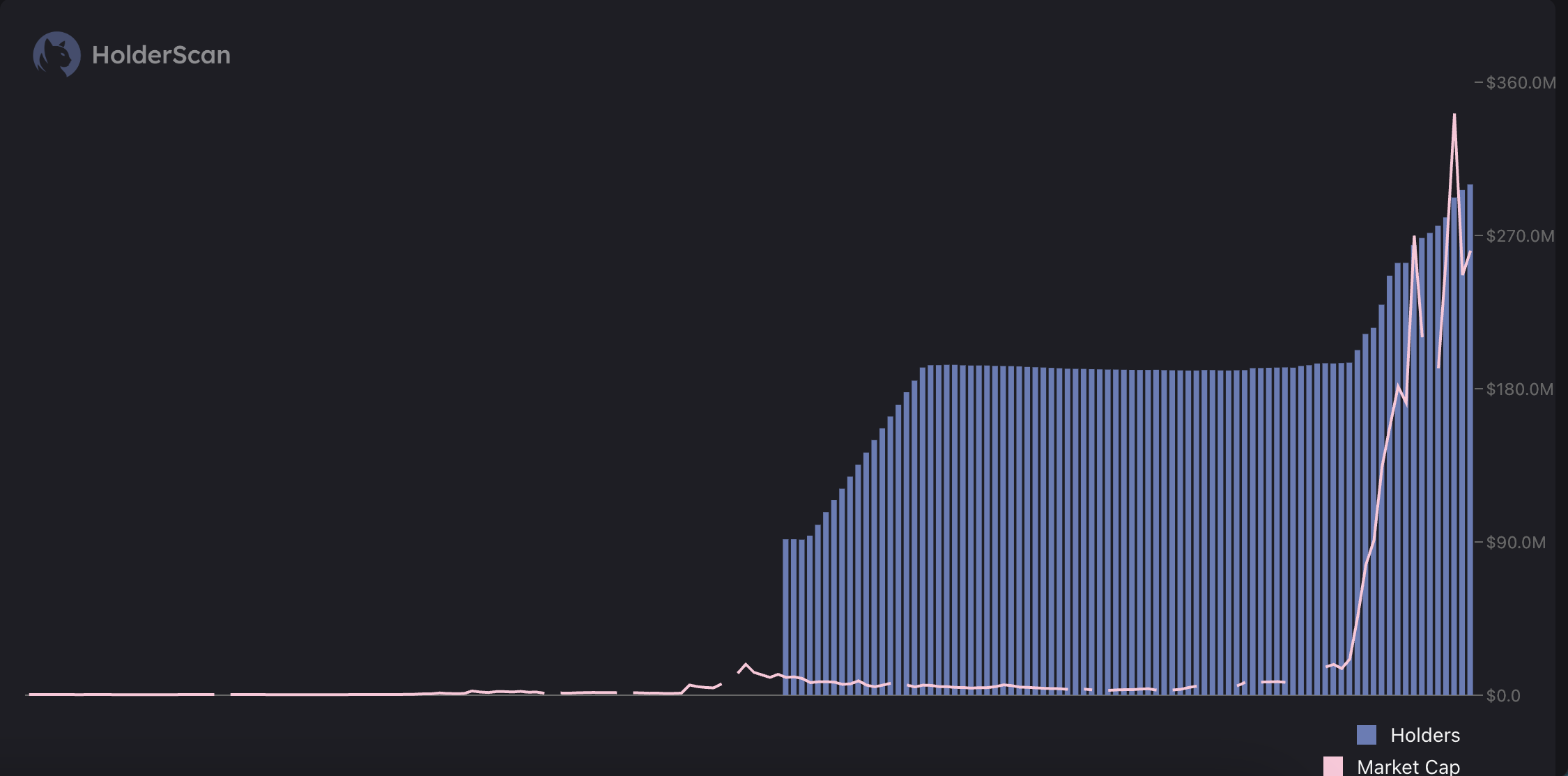Author: Nancy, PANews
Believe is experiencing a backlash in traffic. With the sharp pull of the platform currency LAUNCHCOIN, the successive appearance of tens of millions of fast-pass transactions, and the appeal of a group of Web2 entrepreneurs, Believe once occupied the C position in the recent Launchpad melee and became the focus of traffic. However, behind the excitement, with the platform's high withdrawal, frequent "scraping" phenomenon, and lack of sustainable narrative problems gradually emerging, the community FUD sentiment quickly heated up.
YAPPER's plunge has become the fuse of FUD, and Believe's ecosystem faces multiple hidden dangers
$YAPPER is the fuse of the FUD storm in the Believe ecosystem. According to reports, Yapper is a deep fake AI application used to make funny high-quality videos, and platform users have generated more than 100 million views. Its founder, Emmet Halm, founded the online tutoring company The Massapequa Tutor and the university application platform Acceptitas, both of which have been acquired.

Halm's entrepreneurial experience in the Web2 field quickly attracted attention to the token $YAPPER he launched, and even received multiple retweets from Believe officials to support it, pushing its market value to over $28 million. However, GMGN data shows that as of the time of writing, the maximum drop in the price of $YAPPER from its peak has reached 75.62%.

But this decline is not accidental, and there are multiple factors behind it: On the one hand, Halm was accused of participating in the operation of another token in the Believe ecosystem, $STEALTH, which shares the same logo as the Stealth Startup founded by Halm. In the face of controversy, $STEALTH officials responded vaguely, "This is not plagiarism, nor does it represent an association, because this logo itself is a common symbol of many "secret entrepreneurs", like a signal that an entrepreneur is "invisible"."
Moreover, Halm’s entrepreneurial background has also caused controversy. According to foreign media The Harvard Crimson, Halm, who claims to be a Harvard dropout and crypto entrepreneur, used the slogan “Harvard students help you get into college” when he founded Acceptitas, attracting a large number of customers and tutors. However, after the company was acquired, Halm failed to properly hand over, resulting in a large number of tutors’ salaries being in arrears and customers’ refunds being unresolved, which once aroused legal and ethical doubts.
On the other hand, the issuance of $YAPPER continued the high pumping and scraping phenomenon of the Believe platform, causing retail investors to take over at high prices and suffer serious losses. Among them, Believe's excessively high pumping ratio not only caused serious capital outflow, but also led to excessively high transaction costs for users. According to crypto researcher 0xLoki , the core problem of Believe was highly consistent with that of FriendTech at the time: the net pumping (which would not remain within the ecosystem) was too high, and 4% was gone after one buy and one sell (Believe charged a 2% trading tax). If it is simply estimated based on (the current cumulative transaction volume of the Believe ecosystem) 16.78 billion * 2%, the net pumping has exceeded 33 million US dollars. The internal and external transaction ratio of Pump.fun is estimated at 1:3, and the actual net pumping rate (net pumping/total transaction volume) = 1% * (1/4) = 0.25%. It seems that the transaction fee rate is 1:2, but the actual net pumping rate is 1:8.
"Trading volume is 100m+, but the market value is less than 10m. What does this mean? It means that the dealer directly poured money into the market when retail investors were most FOMO about the trading volume." Crypto KOL @xingpt pointed out. In addition, because Believe allows the rapid creation of tokens through social tags, this method causes the new coins on the platform to be quickly seized by "scrapers" (the behavior of preemptive robots buying tokens at a very fast speed at the moment of token issuance or trading opening) at the opening of the market, and then "pour" (quickly pull up and distribute) the market after pushing up the market value in a short period of time. Retail investors often become the target of buying after FOMO chasing high prices. Data shows that in the past 24 hours, more than half of the tokens on the Believe platform have fallen by more than 50%.
The main control of the market has driven a surge of more than 300 times, and LAUNCHCOIN has contributed more than half of the ecosystem's market value
PANews previously reported that Believe's predecessor was PASTERNAK, a celebrity coin created by Clout founder Ben Pasternak, which was launched in January 2025. Clout is a SocialFi platform that combines the features of platforms such as Friend.Tech, Pump.fun and Moonshot, allowing celebrities and creators to issue tokens named after themselves.
With the endorsement of Alliance DAO and other institutions, PASTERNAK once soared in popularity, and its market value once soared to tens of millions of dollars. However, with the overall market correction and platform technical problems, the price of PASTERNAK subsequently fell sharply, falling to hundreds of thousands of dollars at the lowest. Not only that, the price of $IMRAN (the same name as the founder of Alliance DAO), the second token issued on Clout, also plummeted, exacerbating the loss of market confidence in PASTERNAK.
After a period of silence, on April 29, PASTERNAK announced that it was renamed "Launch Coin on Believe" and used LAUNCHCOIN to violently pull up the market to re-aggregate traffic.

GMGN data shows that since the name change was announced on April 29, LAUNCHCOIN's market value has soared to over US$360 million at one point, with the highest return rate approaching 321 times, demonstrating extremely strong market explosiveness and capital pursuit.

From the perspective of the changes in the addresses holding coins, Holderscan data shows that the number of LAUNCHCOIN holding addresses showed an obvious turning point on May 1, when the market value exceeded 20 million US dollars, the pace of user entry was significantly accelerated, and the attention of funds increased significantly. After nearly ten days of sideways consolidation, LAUNCHCOIN began to accelerate its volume and increase on May 11, and its market value quickly jumped and set a new high.
From the analysis of on-chain data, LAUNCHCOIN is currently highly controlled, with the top 100 addresses controlling more than 54% of the circulating tokens, showing obvious concentrated holding characteristics. This structure, in a sense, shows that there is room for "artificial" dominance in price fluctuations, and the top funds have strong trading capabilities and voice.
In terms of the distribution of coin holdings, the overall average holding amount per person is approximately US$9,100; if the top 100 addresses are excluded, the average holding amount of the remaining nearly 29,000 addresses drops to approximately US$5,600, which indicates that the holding scale of ordinary coin holders is relatively limited, and most investors are small and medium-sized retail investors.
On the whole, LAUNCHCOIN shows a typical pattern of "main force controlling the market + retail investors following suit". The main funds drive market sentiment through trading and attract a large number of retail investors to enter the market.

From the overall situation of the Believe ecosystem, as of now, the platform has issued more than 13,000 tokens, and the total market value of ecological tokens exceeds US$390 million, of which LAUNCHCOIN alone contributes about 67.2% of the market value. At the same time, in the past 24 hours, the transaction volume of LAUNCHCOIN accounted for 35% of the overall ecosystem. It can be seen that the popularity of platform coins is heavily dependent on the market performance of LAUNCHCOIN. However, the platform coin is accused of lacking empowerment such as dividends and practical application scenarios, and the community has great doubts about its long-term sustainability. Once the market heat is difficult to maintain, investor confidence may decline rapidly, and there is a risk of stampede.
Amid multiple market concerns, Ben Pasternak has responded on social media that the past few days have been crazy and he is very grateful for the energy behind the project vision. The team has seen a surge in interest from founders, but will not push new projects on the recommendation board for the time being, but will focus on supporting projects that are already under construction. Believe's top priority is to ensure that they have the tools and resources they need to succeed.
Overall, projects that truly have the ability to cross cycles will eventually return to the fundamentals: product experience, mechanism innovation and community trust. What Believe will face next is not only how to maintain market enthusiasm, but also how to find a sustainable path out of the "coin-making fever".














